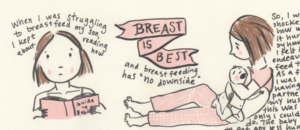Economic policy is taking center stage in this election, with Democrats and Republicans becoming more divided than ever on how to handle the nation’s debt, budget, and other facets of the economy.
Say what you will about the individual candidates, one central theme still stands: Two candidates in this election want to figure out how to make the economy work from the bottom-up, and the other ones are completely uninterested in that.
That’s because the GOP has been steadfastly sticking to “trickle-down” (or “supply-side”) economics since the reign of Ronald Reagan.
And the impact? An economy in which none of the good stuff ever did trickle down – or at least not far enough to help most of us out.
What Is ‘Trickle-Down’ Economics?
Trickle-down economics is a term folks use to refer to “supply-side” economics when they oppose the idea.
The central philosophy of supply-side economics is that reducing government regulation and tax burdens for corporations and the wealthy leads to a collective economic benefit.
In other words, supply-side economics is based around the idea that helping the rich get richer helps everyone else in the long run – because their wealth would “trickle down” to the rest of us.
Whether or not that was ever actually the intention of these policies – or if they were in place just to uphold systems of class privilege – remains unclear.
But if this idea isn’t clicking with you, that makes sense. Because it’s contrary to a lot of the stuff we talk about when we talk about social justice, feminism, and creating social change.
A key idea that’s emerged from conversations about intersectionality is the importance of a bottom-up movement: one where the folks being lifted up, honored, and centered in a push for change are the most disadvantaged.
Many feminists agree that if efforts to create change don’t acknowledge and create solutions for those in need of change the most, those people will never see the change they need.
Unfortunately, it looks like some economists aren’t reading enough Kimberlé Crenshaw. But despite that, most of them recognize that the good ol’ feminist way is the right way, even if they don’t say that word-for-word.
In fact, most economists agree: Trickle-down doesn’t make the economy go anywhere but down.
Almost all of the touted benefits of policies that cut taxes, deregulate the government, and give more power to the rich and—well—powerful have huge holes in their numbers – and it turns out that they mostly have only made the economy worse.
So here’s why it doesn’t work – and the numbers to show it.
1. Government Regulation Is, More Often Than Not, a Good Thing
The notion that government regulation slows business is pretty widely accepted as true. After all, how can commerce flourish under a series of regulatory burdens?
But it turns out that government regulation isn’t hurting the economy at all. In fact, it may be its saving grace.
Economists say that the impact of government regulation is minimal when it comes to job growth, and some studies even show that it could be linked to job creation. And government data has shown that the benefits of regulations outweigh the costs, time and time again.
But most importantly is that just recently, we watched the dangers of deregulation come to a head in the Great Recession – and our economy is still reeling from it.
Deregulation is what led to the housing crisis, and in large part, the Great Recession that followed. Deregulation is what led to the BP oil spill, which wreaked havoc on the economy in addition to the environment.
Deregulation is what leads to the FDA approval of dangerous stuff, car recalls, and other massive failings in which companies lose lots of money – money that is key to growing and maintaining our economy – because they’re given the right to produce and sell sub-par stuff.
And what fixed the Great Recession was, by and large, government involvement.
After all, it’s the government that eventually bailed out the banks and corporations that came crashing down with the economy, and it’s a rise in regulation that’s been helping the economy heal.
It’s regulations that prevent these kinds of environmental disasters from happening. It’s regulations that protect consumers from stuff that hasn’t been properly tested or vetted.
Those who see commerce and government as polar opposites should try harder to envision a world where the two often meet – because regulation is what keeps the economy stable and afloat.
Even better? Regulations, especially environmental regulations, save lives. Regulations give us the eight-hour workday (as opposed to the ten-, twelve-, and fourteen-hour workday). Regulations give us weekends and overtime and the minimum wage and child labor laws and workplace safety protections and diversity requirements.
These are all things that have shifted our society toward equity and away from exploitation and overt bias.
Aside from having economic value, government regulation of commerce and industry has also by and large benefitted the most vulnerable and marginalized people in our economy.
Regulation gives us equal footing in the workplace, and the grounds to demand fair treatment there as well.
Regulation gives us safe food and water and a protected environment.
And regulation has prevented business owners from exploiting some of the lowest-paid laborers in our economy in myriad ways.
Government regulation has, by and large, helped the business world transform into a bigger, better basis for economic growth. And when the business folks tried to do it all alone, they failed.
Big time.
2. Job Growth, Wage Increases, and Income Growth Aren’t Coming from Cutting Taxes
The central claim of trickle-down economics is that cutting taxes leads to a large amount of economic growth benefiting not just the wealthy, but everyone.
And that hasn’t come to fruition, despite decades of politicians putting policies into place that echo the theory.
Instead, data shows that cutting taxes at the top doesn’t lead to economic growth, job growth, income growth, or even higher wages.
Tax cuts also don’t increase the government’s overall revenue, although politicians love to claim that the money corporations and wealthy individuals save on taxes will foster innovation and creation that stimulates the economy.
In fact, economists have been unable to identify any correlation between tax rates and economic growth, proving that the central thesis behind trickle-down is a myth.
And a leading reason why is because the folks at the top haven’t been holding up their part of the whole deal.
Cuts to the top tax rate were supposed to stimulate the economy by encouraging business owners and folks with more financial resources to give more back. Workers, for example, were supposed to expect higher wages – because their business’ owners were paying less taxes, and there was more to go around.
But data shows that wages are either stagnant or declining in some industries. And despite years of tax cuts for the wealthy, folks leading corporations are widely opposed to even raising the minimum wage.
Average, everyday people are the heart of the American economy. Without a labor force, no business or industry would thrive.
But instead of rewarding their workers and taking it upon themselves to quite literally share the wealth, folks earning at the top tax rate and running their own businesses are centralizing wealth instead.
Instead of leading to a more robust and equitable economy, trickle-down policies have made surviving even more of a challenge for middle- and lower-income folks in this country.
Cuts to the top tax rate in trickle-down economics don’t just not trickle down. They’ve also played a huge part in creating the lopsided country we live in now where 1% of Americans own 40% of our capital. (That leaves 99% of us to fight for the rest.)
3. The Economy Isn’t Growing, But It Could Be – With More Taxes on the Rich
Tax cuts on the rich – which was put forward by trickle-down proponents as a pathway to greater wealth for all – don’t help anyone but the people getting those tax cuts.
But raising taxes on the wealthy would help everyone.
Our current tax rates fly in the face of what we know about economic growth. Data shows that taxing the wealthy actually promotes economic growth, and that when the poor earn more, everyone benefits.
But instead of turning that knowledge into policy, and advancing a higher minimum wage and tax hikes for the wealthiest Americans, politicians are clinging to a failing economic theory – and the people suffering the consequences are people like you and me.
The most obvious – and important – thing to note about trickle-down economic policies is that there has been no “collective benefit.”
There has been no benefit from trickle-down policies to communities of color or women. Instead, the amount of Americans living near or under the poverty line has been increasing, and the “working poor” is expanding.
Corporations receive welfare that everyday Americans could only dream of. Tech companies are stimulating the economy but ripping off their workers, as are businesses across sectors that exploit low-wage workers.
Instead of fostering growth among the middle- and lower-class, economic policies benefitting the rich have done just that – benefit the rich.
Wealth is more concentrated than ever, and the middle class is smaller than ever. As such, trickle-down has turned into a way to keep everyone except the super-rich down.
***
The numbers on these policies speak volumes.
It’s important to be aware that government regulation is more beneficial than hurtful – and oftentimes, simply neutral – when it comes to its impact on job growth, wage stagnation, and sustainability in the economy.
It’s important that we’ve been able to link the Great Recession to harmful economic policies that ignore the challenges of poor and middle-class Americans.
It’s important that we know better than to believe that cutting taxes for the wealthy puts more money in any of our wallets.
It’s important that we stop trying to use failed policies to stimulate job growth, wage increases, and income growth.
But it’s even more important that we not lose sight of what these numbers stand for. Because what they symbolize are actual lives and experiences.
It’s not the economy that suffered when banks needed to be bailed out after deregulation and predatory lending schemes landed them in hot water. It was most of us.
It’s not the economy that suffered when the job market hit rock-bottom, and it’s not the economy that’s struggling to keep up with inflation when wages have remained stagnant and even gone down over the last few decades. It was most of us.
The economy isn’t a person. But it impacts every single person who pays into it, operates inside of it, and wants a slice of it for themselves.
Trickle-down policies don’t just break the economy. They break up our chances at a better tomorrow.
They crush our shot at lifting up the poor, strip our power as workers, and fuel inequality. Instead of closing the wealth gap, these policies exacerbated it. And that means that more of us fell into the cracks.
As feminists, we know that advocating for the most vulnerable and the most marginalized comes with the territory. And it’s why we can’t let policies that have failed us for decades stay in place.
[do_widget id=’text-101′]
Carmen Rios is a Contributing Writer for Everyday Feminism. She splits her time disparately between feminist rabble-rousing, writing, public speaking, and flower-picking. A professional feminist by day and overemotional writer by night, Carmen is currently Communications Coordinator at the Feminist Majority Foundation and the Feminism and Community Editor at Autostraddle. You can follow her on Twitter @carmenriosss and Tumblr to learn more about her feelings.
Search our 3000+ articles!
Read our articles about:
Our online racial justice training
Used by hundreds of universities, non-profits, and businesses.
Click to learn more





















